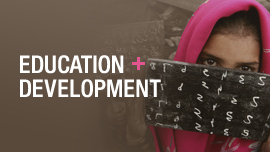Bringing a promising or proven innovation to new people or harnessing different modes of delivering its impact is never as simple as “copy and paste.” In fact, much of what makes a scaling process successful lies outside the innovation itself and is subject to influences from the broader environment in which it’s to be adopted. This is why scaling is neither simple nor easy. Effective scaling requires establishing partnerships with many, cultivating an enabling environment, being open to adaptation along the way, and maintaining long-term focus on one’s scaling goal and the pathways to get there.
It’s not that one route is inherently better than the others; it’s that there needs to be alignment among goals, resources, and details of the journey.
Our research over the past five years through the Research on Scaling the Impact of Innovations in Education (ROSIE) project found that a key component of scaling education innovations is identifying the right pathway to scale and knowing when and how to adapt it during the scaling journey. In the consumer and technology sectors, the scaling focus is often on “market penetration” or “customer adoption.” But these private-sector pathways don’t necessarily map onto the social sectors. Education is a public good rooted in the politics and histories of a location, which makes it different from how products in a private sector are introduced into a marketplace and scaled. Scaling in education involves multiple actors and beneficiaries—often with competing interests and opinions about education—and countless complexities across an ecosystem.
Choosing the right pathway for scaling
Identifying the right pathway for scaling the impact of a particular innovation in a specific context is an essential step in any scaling journey. Determining which scaling pathway(s) to pursue first requires identifying the appropriate scaling goal and, second, matching that goal with the innovation’s features and constraints, the local context and broader environment, resource assets and limitations, and the scaling organization’s own strengths and capacities. Just like with a car trip, there are multiple routes to choose from and picking the right one is about fitting together the route, vehicle, trip parameters, and overall goal. It’s not that one route is inherently better than the others; it’s that there needs to be alignment among goals, resources, and details of the journey. Further, different pathways may be used to get to the same scaling goal—and (unlike with the car trip) sometimes multiple pathways can be pursued simultaneously.
What’s a scaling goal?
The concrete, measurable, long-term vision of impact at scale. It lays out how an innovation will create impact and details when, where, and how many people will be impacted once the goal is reached.
What’s a scaling pathway?
The method for making progress toward the scaling goal. In other words, how you will get to impact at scale.
Over the last 18 months, ROSIE has been supporting and learning alongside 42 scaling research teams in the Global Partnership for Education’s Knowledge and Innovation Exchange (KIX) as they conduct research to identify and assess pathways to scale for their own education initiatives. As part of this, we’ve been working to develop a better understanding of scaling pathways for use in the education space in low- and middle-income countries.
Developing 2 animated story videos
Since 2016, the Millions Learning team at Brookings has been working with partners around the world to create a coherent scaling pathways framework. Our framework has gone through multiple iterations and been influenced by other similar frameworks that label and categorize scaling pathways in social sectors. However, after a decade of piloting, revising, and reflecting on our framework, we’ve come to see that the particular naming or categorizing of pathways (e.g., horizontal or vertical; scaling up, out, or down; mainstreaming) matters less than the actual work of:
- Clearly identifying and articulating one’s scaling goal,
- Carefully examining and evaluating the available options to get there,
- Purposefully selecting one or more promising pathways in collaboration with partners, and
- Being prepared to adapt or rethink the chosen pathway(s) along the way.
Additionally, we’ve found that discussing scaling pathways in the abstract makes it more confusing, not less so—especially when terminology is used. But when people talk about scaling pathways in relation to their own work, the concept becomes clearer for them and us. For example, ROSIE research conducted last year found that many KIX research teams struggled to name or categorize “their scaling approach” but could describe in great detail the particulars of how they’re approaching the work of meeting their scaling goals.
Built on this learning, we developed a two-part animated video series that moves away from focusing on frameworks and instead shares what we know in narrative form, using a hypothetical example to ground scaling pathways in specifics. It’s our hope that these short videos will assist scaling teams (and those who support and work with them) to better understand the concept of scaling pathways in education and how pathways are distinct from, but closely linked to, scaling goals.
The first video presents a fictional team working on a teaching-related innovation as they collaboratively explore and ultimately select a scaling pathway. As the video illustrates, this process requires considering who will deliver the innovation both during the scaling process and at scale, who will pay for the innovation during scaling and at scale, and what methods will be pursued to achieve the scaling goal.
The second video follows the same team a few years later, as they must now assess how things have changed during their journey, what benefits and trade-offs their initial pathway currently offers, how to navigate new opportunities and challenges, and ways to reassess if and how the pathway needs to be replaced or adjusted.
The two videos, meant to be watched in succession, illustrate a complex piece of the puzzle of scaling impact in education. The videos (available in English with subtitles in French and Spanish) are best viewed multiple times—ideally, pausing along the way to discuss with your team—as a method for deepening understanding of how to bring an innovation’s impact to more people and locations in sustainable ways.
We hope you’ll let us know if the videos work for you and, if they don’t, how they can be improved. Additionally, for readers who wish for more, our scaling strategy worksheet is a good accompaniment to the videos.
The Brookings Institution is committed to quality, independence, and impact.
We are supported by a diverse array of funders. In line with our values and policies, each Brookings publication represents the sole views of its author(s).









Commentary
A visual guide to rethinking pathways to scale in education
November 10, 2025